并列句和状语从句知识讲解
- 格式:ppt
- 大小:178.50 KB
- 文档页数:16
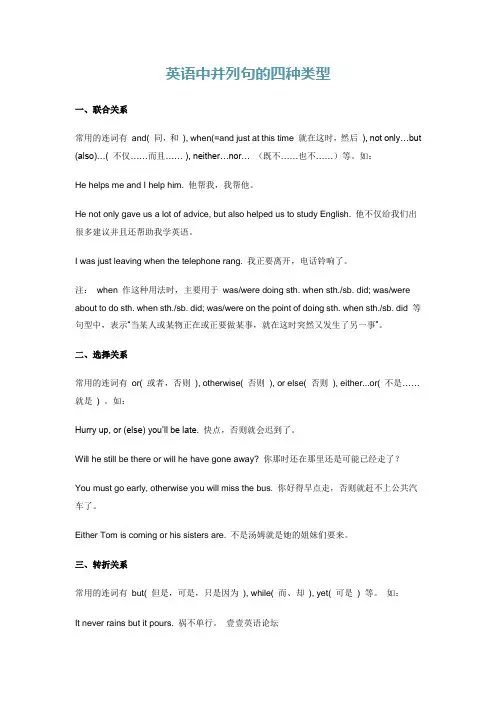
英语中并列句的四种类型一、联合关系常用的连词有and( 同,和), when(=and just at this time 就在这时,然后), not only…but (also)…( 不仅……而且…… ), neither…nor… (既不……也不……)等。
如:He helps me and I help him. 他帮我,我帮他。
He not only gave us a lot of advice, but also helped us to study English. 他不仅给我们出很多建议并且还帮助我学英语。
I was just leaving when the telephone rang. 我正要离开,电话铃响了。
注:when 作这种用法时,主要用于was/were doing sth. when sth./sb. did; was/were about to do sth. when sth./sb. did; was/were on the point of doing sth. when sth./sb. did 等句型中,表示“当某人或某物正在或正要做某事,就在这时突然又发生了另一事”。
二、选择关系常用的连词有or( 或者,否则), otherwise( 否则), or else( 否则), either...or( 不是……就是) 。
如:Hurry up, or (else) you’ll be late. 快点,否则就会迟到了。
Will he still be there or will he have gone away? 你那时还在那里还是可能已经走了?You must go early, otherwise you will miss the bus. 你好得早点走,否则就赶不上公共汽车了。
Either Tom is coming or his sisters are. 不是汤姆就是她的姐妹们要来。
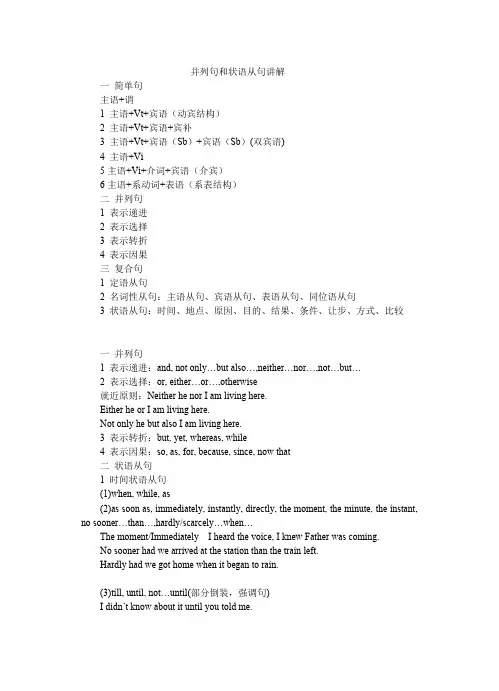

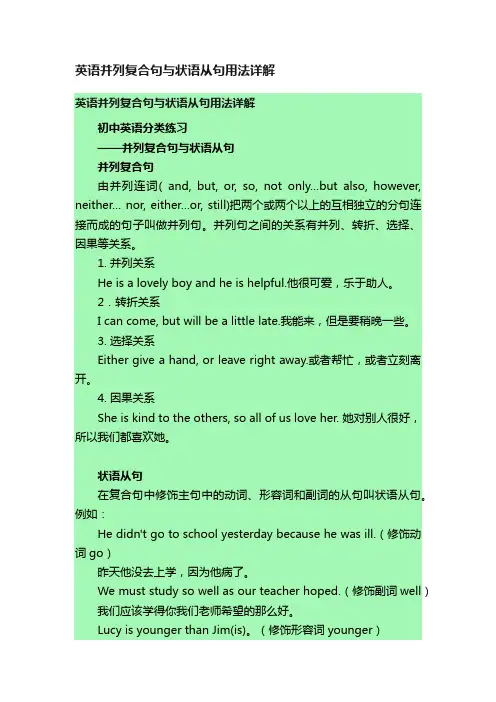
英语并列复合句与状语从句用法详解英语并列复合句与状语从句用法详解初中英语分类练习——并列复合句与状语从句并列复合句由并列连词( and, but, or, so, not only…but also, however, neither… nor, either…o r, still)把两个或两个以上的互相独立的分句连接而成的句子叫做并列句。
并列句之间的关系有并列、转折、选择、因果等关系。
1. 并列关系He is a lovely boy and he is helpful.他很可爱,乐于助人。
2.转折关系I can come, but will be a little late.我能来,但是要稍晚一些。
3. 选择关系Either give a hand, or leave right away.或者帮忙,或者立刻离开。
4. 因果关系She is kind to the others, so all of us love her. 她对别人很好,所以我们都喜欢她。
状语从句在复合句中修饰主句中的动词、形容词和副词的从句叫状语从句。
例如:He didn't go to school yesterday because he was ill.(修饰动词go)昨天他没去上学,因为他病了。
We must study so well as our teacher hoped.(修饰副词well)我们应该学得你我们老师希望的那么好。
Lucy is younger than Jim(is)。
(修饰形容词younger)露茜比吉姆年轻。
状语从句的语序应是主语+谓语+其他成分,即陈述句的语序。
状语从句的位置,可以放在主句前面或后面,但是若放在主句前面,要用逗号与主句分开;主句若是疑问句,那么时间状语从句只能放在主句的前面。
状语从句的用法状语从句根据它表达的意思不同可分为时间状语从句、原因状语从句、条件状语从句、比较状语从句、目的状语从句、结果状语从句和让步状语从句。
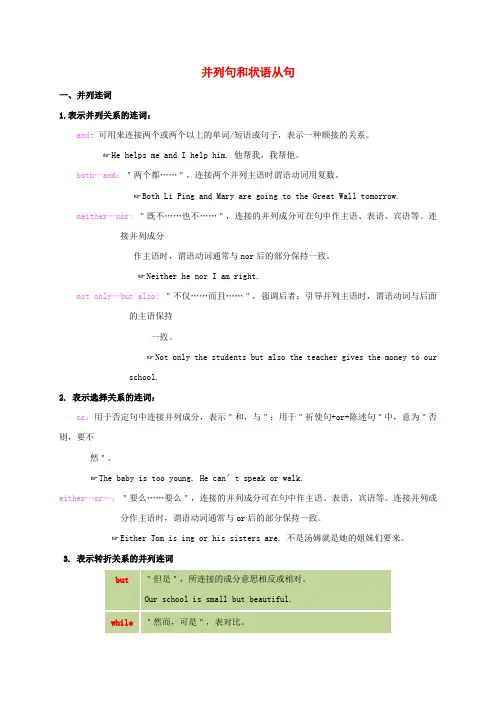
并列句和状语从句一、并列连词1.表示并列关系的连词:and: 可用来连接两个或两个以上的单词/短语或句子,表示一种顺接的关系。
☞He helps me and I help him. 他帮我,我帮他。
both…and:"两个都……",连接两个并列主语时谓语动词用复数。
☞Both Li Ping and Mary are going to the Great Wall tomorrow.neither…nor: "既不……也不……",连接的并列成分可在句中作主语、表语、宾语等。
连接并列成分作主语时,谓语动词通常与nor后的部分保持一致。
☞Neither he nor I am right.not only…but also: "不仅……而且……",强调后者;引导并列主语时,谓语动词与后面的主语保持一致。
☞Not only the students but also the teacher gives the money to our school.2. 表示选择关系的连词:or:用于否定句中连接并列成分,表示"和,与";用于"祈使句+or+陈述句"中,意为"否则,要不然"。
☞The baby is too young. He can’t speak or walk.either…or…:"要么……要么",连接的并列成分可在句中作主语、表语、宾语等。
连接并列成分作主语时,谓语动词通常与or后的部分保持一致。
☞Either Tom is ing or his sisters are. 不是汤姆就是她的姐妹们要来。
3. 表示转折关系的并列连词4. 表示因果关系的并列连词for :so : 4. when 可作并列连词,意为“正在这时”,表示某件事正在发生或刚刚发生时,突然发生另一动作。
⎩⎪⎨⎪⎧ be about to do...when...be doing...when...be on the point of doing...when...had just done...when...☞Tom was about to close the window when his attention was caught by a bird.汤姆正要关窗户,这时他的注意力被一只鸟吸引住了。
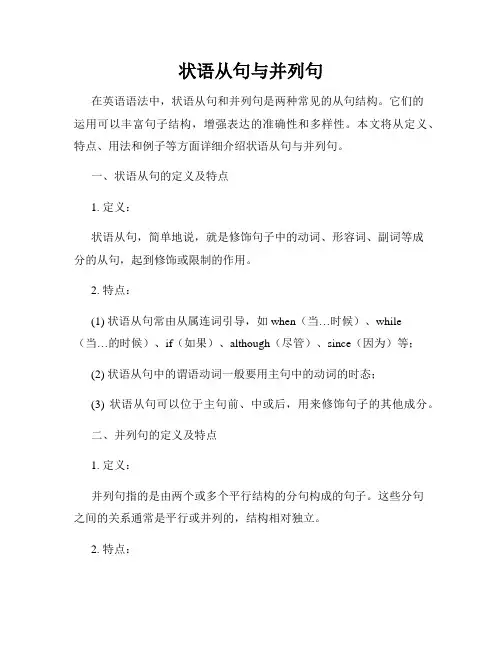
状语从句与并列句在英语语法中,状语从句和并列句是两种常见的从句结构。
它们的运用可以丰富句子结构,增强表达的准确性和多样性。
本文将从定义、特点、用法和例子等方面详细介绍状语从句与并列句。
一、状语从句的定义及特点1. 定义:状语从句,简单地说,就是修饰句子中的动词、形容词、副词等成分的从句,起到修饰或限制的作用。
2. 特点:(1) 状语从句常由从属连词引导,如when(当…时候)、while (当…的时候)、if(如果)、although(尽管)、since(因为)等;(2) 状语从句中的谓语动词一般要用主句中的动词的时态;(3) 状语从句可以位于主句前、中或后,用来修饰句子的其他成分。
二、并列句的定义及特点1. 定义:并列句指的是由两个或多个平行结构的分句构成的句子。
这些分句之间的关系通常是平行或并列的,结构相对独立。
2. 特点:(1) 并列句中的分句之间一般用逗号或并列连词连接,如and(和)、but(但是)、or(或者)等;(2) 并列句中的分句通常要保持结构平行,包括时态、语态、语气等方面的平行。
三、状语从句的用法及例子1. 时间状语从句:时间状语从句用来表示动作发生的时间,常由when、while、before、after、since等引导。
例子:- I will call you when I arrive at the airport.(当我到达机场时,我会给你打电话。
)- She was watching TV while her mother was cooking.(她妈妈在做饭的时候,她在看电视。
)2. 条件状语从句:条件状语从句用来表示主句动作发生的条件,常由if、unless、on condition that等引导。
例子:- If it rains tomorrow, we will stay at home.(如果明天下雨,我们会待在家里。
)- You can go outside unless it is too cold.(除非天气太冷,你可以出去玩。
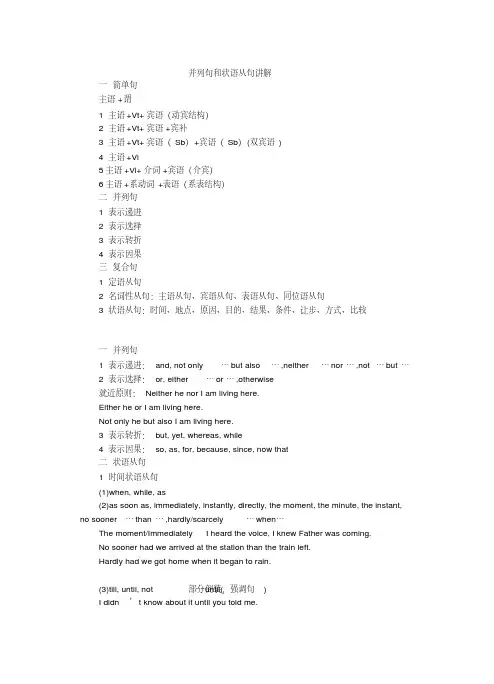
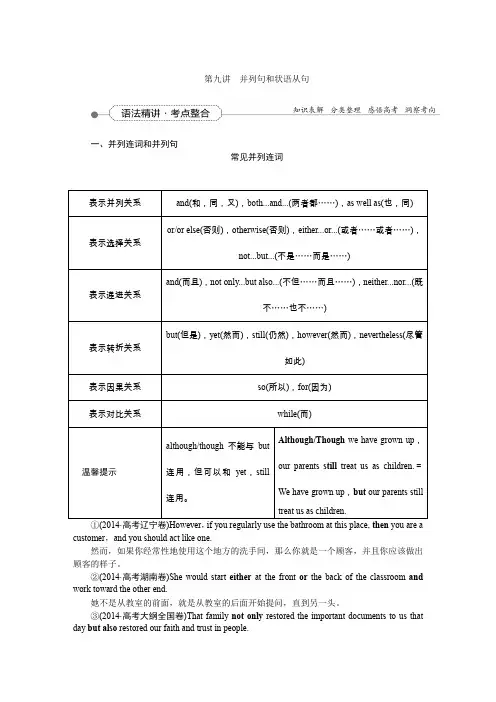
第九讲并列句和状语从句一、并列连词和并列句常见并列连词温馨提示customer,and you should act like one.然而,如果你经常性地使用这个地方的洗手间,那么你就是一个顾客,并且你应该做出顾客的样子。
②(2014·高考湖南卷)She would start either at the front or the back of the classroom and work toward the other end.她不是从教室的前面,就是从教室的后面开始提问,直到另一头。
③(2014·高考大纲全国卷)That family not only restored the important documents to us that day but also restored our faith and trust in people.那个家庭在那天不仅归还了我们那份重要的文档,还让我们重新拥有了对人的信心和信任。
④(2013·高考新课标全国卷Ⅱ)I was glad to meet Jenny again,but I didn’t want to spend all day with her.很高兴又见到Jenny了,但是我不想花一整天时间和她在一起。
⑤(2015·苏州高三模拟)Yesterday,I forgot to pick my son up,so he waited in the kindergarten for nearly two hours.昨天我忘记去接我的儿子了,因此他在幼儿园等了几乎两个小时。
⑥At school,some students are active while some are shy,yet they can be good friends with one another.在学校,有些学生是活跃的而有些学生是害羞的,但是他们可以成为彼此的好朋友。
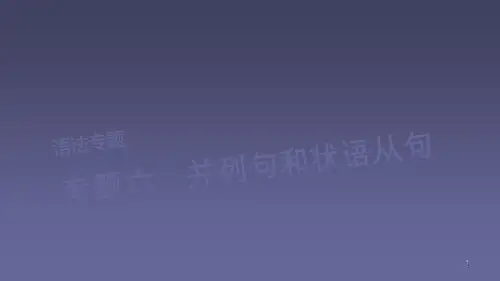
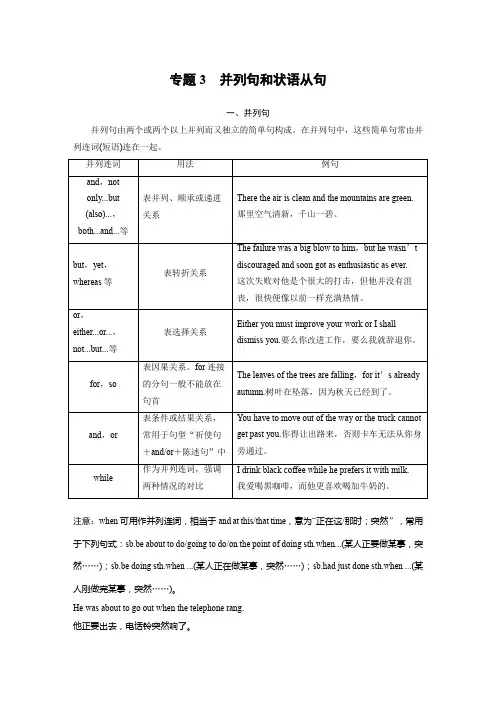
专题3并列句和状语从句一、并列句并列句由两个或两个以上并列而又独立的简单句构成。
在并列句中,这些简单句常由并列连词(短语)连在一起。
注意:when可用作并列连词,相当于and at this/that time,意为“正在这/那时;突然”,常用于下列句式:sb.be about to do/going to do/on the point of doing sth.when...(某人正要做某事,突然……);sb.be doing sth.when ...(某人正在做某事,突然……);sb.had just done sth.when ...(某人刚做完某事,突然……)。
He was about to go out when the telephone rang.他正要出去,电话铃突然响了。
He had just finished writing a report when the boss let him type a letter.他刚写完一篇报告,老板就让他打印一封信件。
单句语法填空1.At school,some students are active while some are shy,yet they can be good friends with one another.2.The other day I was doing some grocery shopping when a man walked toward a group of us at the checkout stand.3.Follow your doctor’s advice,or your cough will get worse.4.John plays basketball well,but/yet his favorite sport is badminton.二、状语从句考点一让步状语从句单句语法填空1.The athletes,especially the winners,should remain modest whatever rapid progress they have made.2.Much as/though I have traveled,I have never seen anyone who’s as capable as John. 3.Don’t trust him,no matter what he says.4.While/Although/Though I admit that there are problems,I don’t agree that they cannot be solved. 5.I’ll do it,even if/though it takes me all the afternoon.6.We’ll go on with the work,whether we can find the necessary tools or not.7.No matter how hard the work is,you’d better try to do it well.考点二时间状语从句单句语法填空1.Not until we succeed in letting wildlife live in peace can we smile in relief.2.Air pollution is getting more and more serious,so we must take action before it is too late. 3.He had no sooner finished his speech than the students started cheering.4.While watching TV,children do not merely absorb words and images.5.As he grew older,he became less active.。
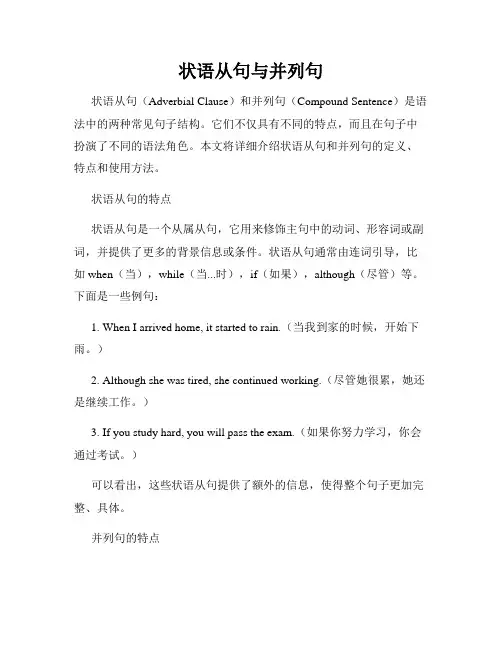
状语从句与并列句状语从句(Adverbial Clause)和并列句(Compound Sentence)是语法中的两种常见句子结构。
它们不仅具有不同的特点,而且在句子中扮演了不同的语法角色。
本文将详细介绍状语从句和并列句的定义、特点和使用方法。
状语从句的特点状语从句是一个从属从句,它用来修饰主句中的动词、形容词或副词,并提供了更多的背景信息或条件。
状语从句通常由连词引导,比如when(当),while(当...时),if(如果),although(尽管)等。
下面是一些例句:1. When I arrived home, it started to rain.(当我到家的时候,开始下雨。
)2. Although she was tired, she continued working.(尽管她很累,她还是继续工作。
)3. If you study hard, you will pass the exam.(如果你努力学习,你会通过考试。
)可以看出,这些状语从句提供了额外的信息,使得整个句子更加完整、具体。
并列句的特点并列句是由两个或多个独立的子句组成的句子,这些子句平等地并列在一起,通过逗号、分号或者连词来连接。
并列句的结构如下:[独立子句1],[连词] [独立子句2]。
常见的并列连词有and(和)、but(但是)、or(或者)等。
下面是一些例句:1. I like playing basketball, and my sister likes playing tennis.(我喜欢打篮球,我姐姐喜欢打网球。
)2. It was raining heavily; therefore, we decided to stay at home.(雨下得很大,所以我们决定呆在家里。
)3. You can either come with us, or you can stay here.(你可以跟我们一起去,也可以留在这里。
主语+谓语主语+谓语+宾语简单句主语+谓语+宾语+宾语补足语主语+谓语+间接宾语+直接宾语主语+系动词+表语表递进表选择并列句表转折表因果其他句子定语从句(形容词性从句)主语从句名词性从句宾语从句表语从句同位语从句复合句状语从句(副词性从句)常考点清单一并列句一、并列句的概念并列句是由两个或两个以上并列而独立的简单句构成.在并列句中,这些简单句常由并列连词连在一起二、常见的并列句1.表递进关系:用来表递进关系的并列连词有:and,not only...but also...,neither...nor...,not...but....等.如:He had plenty of money and he spent it freely.Not only did he speak more correctly,but also he spoke more easily.2.表示选择关系:常用的并列连词有:or,either...or...,otherwise等如:Either you or I am right.Don't drive so fast or/otherwise you will have an accident.3.表示转折关系:常用的并列连词有:but,yet,while等如:Tom said he was ill,yet I saw him in the street just now.Some men are rich,while others are poor.4.说明因果关系:常用的并列连词有so,forIt must have rained last night for it is wet all over.The shops were closed so I didn't get any milk.5.when还可以做并列连词,其意义为“那时,这时”.(at this/that time)常用于下列句式:①Sb was doing sth when......②Sb was about to/going to do sth when......I was reading a magazine when my mother came in.We were about to set off when it suddenly began to rain.(be about to......when......)6.while作为并列动词,意为“而,却”,表示对比He likes pop music while I am fond of folk music.常考点清单二时间状语从句一、when,while,和as1.when(既可以引导一个延续动作,也可以引导一个短暂动作;可用于主句和从句动作同时发生)如:When I lived there,I used to go to the seaside on Sundays.2.while引导的动作必须是持续性的,侧重于主句动作和从句动作的对比I was watching TV while my mother was cooking.(while可作让步状语从句从属连词,意为“尽管”While I admit that there are problems,I don't agree that they can not be solved.)3.as可表示“当......的时候”;“随着......”如:As a young man,he was fond of reading.As time goes by,it is getting warmer and warmer.二、as soon as,the moment,no sooner......than......,hardly/scarcely...... when(一...就...)The moment I heard the voice,I knew father was coming.No sooner had we arrived at the station than the train left.三、till,until和not......until1.肯定句:主句的谓语动词必须是延续动词,主句、从句都为肯定式,意为“某动作一直延续到某时间点才停止”如:He remained there until/till she arrived.2.否定句:主句的谓语动词必须是延续性动词,从句为肯定式,意为“直到......才”He did n't go to bed until his mother returned.①It was not until you told me that I had any idea of it.(强调句)②Not until you told me did I have any idea of it.(倒装句)四、before和since①before表示“还未......就......;还没来得及”We had sailed four days and four nights before we saw land.Before they reached the station,the train had gone.②It will be+一段时间+before......还要多久才......如:It will be half a year before I come back.It won't be long before we meet again.since 从句的谓语动词一般是非延续性动词,主句的谓语动词是延续动词的或者是反复发生过的动作.since 从句的时态若是一般过去时,相应的,主句中的时态是现在完成时或现在完成进行时如:I have written home four times since I came here.She has been working in this factory since she left school.常考清单三地点状语从句地点状语从句1.引导地点状语从句的从属连词where(在...的地方)We should go to where the Party needs us most.Where there is a will,there is a way.2.where引导的定语从句与状语从句的区分:You had better make a mark where you have any questions.(状语从句)You had better make a mark at the place where you have any questions.(定语从句)常考点清单四原因状语从句引导原因状语从句的从属连词有:because(因为) as(由于) since/ now that(既然)He didn't come to school because he was ill.As it is raining hard,we will n’t go to the park.Now that/Since everybody is here,let's begin our meeting.常考点清单五目的状语从句目的状语从句引导目的状语从句的从属连词有:so that,in order that,in caseI will speak slowly so that you can understand me.In order that we might see the sunrise,we started for the peak early.Take your raincoat in case it rains.常考点清单六结果状语从句1.引导结果状语从句的从属连词有so......that......;such......that......其结构形式:so+形容词/副词+that从句so+形容词+a/an+可数名词单数形式+that从句such+a/an+形容词+可数名词+that从句Tom is so honest a worker that we all believe him.Tom is such an honest worker that we all believe him.It is such fine weather that we all want to go to the park.2.too......to......(太......而不能);so......as to......(那么...以至于)He got up too late to catch the bus.He got up so late as to miss the bus.常考点清单五条件状语从句条件状语从句引导条件状语从句的从属连词有:if(如果);unless(if...not除非/如果不);so/as long as(只要);in case(万一);on condition that(条件是)You will fail the exam unless you study hard.As long as you don't lose heart,you will succeed.In case there is a fire,what will we do first?常考点清单六让步状语从句让步状语从句1.引导让步状语从句的从属连词有:although/though(即使,尽管),even though/even if(即使)(可以和yet,still连用,但不能和but连用)He is unhappy,though/although he has a lot of money.Although it was raining hard,they went on playing football.2.though可用作副词,意为“可是,然而”置于句末如:He said he would come;he didn't,though.3.as或though引导让步状语从句时倒装的情况(表语、状语、动词)Child as/though he is,he knows a lot.Much as/though I like it,I won't buy it for it is too expensive.4.whether...or......(不管...还是...);疑问词+ever与no matter+疑问词(不管.....;无论.....)如:Whether you believe it or not,it is true.Whatever you say,he won't believe you.状语从句专项练习题1.—Our holiday cost a lot of money.—Did it?Well,that doesn't matter_______you enjoyed yourselves.A.as long asB.unlessC.as soon asD.though2.Tom was about to close the window_______his attention was caught by a bird.A.whenB.ifC.andD.till3._______volleyball is her main focus,she is also good at basketball.A.SinceB.OnceC.UnlessD.While4._______our manager objects to Tom's joining the club,we shall accept him as a member.A.UntilB.UnlessC.IfD.After5.The engineer are so busy that they have zero time for outdoor sports activities,_______they have the interest.A.whereverB.wheneverC.even ifD.as if6.It was April 29,2011_______Prince William and Kate Middleton walked into the palace hall of the wedding ceremony.A.thatB.whenC.sinceD.before7.The little boy won't go to sleep_______his mother tells him a story.A.orB.unlessC.butD.whether8.The old man asked Lucy to move another chair_______he wanted to sit next to his wife.A.althoughB.unlessC.becauseD.if9.Please call my secretary to arrange a meeting this afternoon,or_______it is convenient to you.A.wheneverB.howeverC.whicheverD.wherever10.You may use the room as you like_______you clean it up afterwards.A.so far asB.so long asC.in caseD.even if11.My parents don't mind what job I do_______I am happy.A.even thoughB.as soon asC.as long asD.as though12._______unemployment and crime are high,it can be assumed that the latter is due to the former.A.BeforeB.WhereC.UnlessD.Until13.He had no sooner finished his speech_______the students started cheering.A.sinceB.asC.whenD.than14.—Shall we have our picnic tomorrow?—_______it doesn't rain.A.UntilB.WhileC.OnceD.If15.Owen wouldn't eat anything_______he cooked it himself.A.untilB.sinceC.unlessD.while16._______the police thought he was the most likely one,since they had no exact proof about it,they could not arrest him.A.AlthoughB.As long asC.If onlyD.As soon as17._______all of them are strong candidates(候选人),only one will be chosen for the post.A.SinceB.WhileC.IfD.As soon as18.She had just finished her homework_______her mother asked her to practice playing the piano yesterday.A.whenB.whileC.afterD.since19.—Have you got any idea for the summer vacation?—I don't mind where we go_______there is sun,sea and beach.A.as ifB.as long asC.now thatD.in order that20.A small car is big enough for a family of three_______you need more space for baggage.A.onceB.becauseC.ifD.unless21.—Did you return Fred's call?—I didn't need to_______I will see him tomorrow.A.thoughB.unlessC.whenD.because22.Frank insisted that he was not asleep_______I had great difficulty in waking him up.A.whetherB.althoughC.forD.so23.All people,_______they are old or young,rich or poor,have been trying their best to help those in need since the disaster.A.even ifB.whetherC.no matterD.however24.We will have a picnic in the park this Sunday_______it rains or it's very cold.A.sinceB.ifC.unlessD.until25.As is reported,it is 100 years_______Qinghua University was founded.A.whenB.beforeC.afterD.since26.I used to love that film_______I was a child,but I don't feel it that way any more.A.onceB.whenC.sinceD.although27.I won't call you,_______something unexpected happens.A.becauseB.whetherC.unlessD.while28._______he had not hurt his leg,John would have won the race.A.IfB.SinceC.ThoughD.When29._______regular exercise is very important,it is never a good idea to exercise too close to bedtime.A.IfB.AsC.AlthoughD.Unless30.He was told that it would be at least three more months_______he could recoverand return to work.A.whenB.beforeC.sinceD.that31.Mary made coffee_______her guests were finishing their meal.A.so thatB.althoughC.whileD.as if32.John thinks it won't be long_______he is ready for his new job.A.whenB.afterC.beforeD.since33.Today,we will begin_______we stopped yesterday so that no point will be left out.A.whenB.whereC.howD.what34._______they decide which college to go to,students should research the admission procedures.A.AsB.WhileC.UntilD.Once35.Just use this room for the time being,and we will offer you a larger one_______it becomes available.A.as soon asB.unlessC.as far asD.until36.Don't promise anything_______you are one hundred percent sure.A.whetherB.afterC.howD.unless37._______the Internet is of great help,I don't think it is a good idea to spend too much time on it.A.IfB.WhileC.BecauseD.As38.The school rules state that no child shall be allowed out of the school during the day,_______accompanied by an adult.A.onceB.whenC.ifD.unless39.—How about camping this weekend,just for a change?—OK,_______you want.A.whicheverB.howeverC.whateverD.whoever40.You can't borrow books from the school library_______you get your student card.A.beforeB.ifC.whileD.as41.All the dishes in this menu,_______otherwise stated,will serve two to three people.A.asB.ifC.thoughD.unless42.The lawyer seldom wears anything other than a suit_______the season.A.whateverB.whereverC.wheneverD.however43.Because of the heavy traffic,it was already time for lunch break_______she got to her office.A.sinceB.thatC.whenD.until44.I am sorry you have been waiting so long,but it will still be some time_______Brain gets back.A.beforeB.sinceC.tillD.after45.Animals suffered at the hands of Man_______they were destroyed by people to make way for agricultural land to provide food for more people.A.in whichB.for whichC.so thatD.in that。
并列句与状语从句讲解连词是一种虚词,不能在句子中单独作句子成分,在句子中只起连接词与词、短语与短语、句子与句子以及从句的作用;一、并列句与连词连接同一语法类型的词、短语或句子1. 并列连词的分类并列连词按其作用可分为表示转折对比、因果、选择和并列四大类;1 表示转折的并列连词1.but但是,可连接两个句子,用逗号隔开;也可以放在句首2.yet 然而,尽管如此,连接两个句子,用逗号隔开;也可以放在句首The car is old,yet it is in good condition.注:yet也常放在完成时句尾表示还没有,此时不是连词,注意区分;3.while 而,可是,表示转折或对比,不用加逗号Lily likes go to school by bus while linda likes go to school by bike.4.however 然而,但是,一般位于句首,单个使用后加逗号阅读完型中常见到表转折;它们连接两个意思不同,阅读中遇到要注意;2 表示因果的并列连词表示因果的并列连词有:1.for 因为①由并列连词for 引导的分句常置于句子后部,而且常用逗号与前面的分句隔开;②for 分句主要是对前一分句补充说明理由或推断原因;③for 分句不能用来回答why 问句;She can’t go to school , for she is ill in bed.2.so 所以可以连接两个句子,中间有时用逗号隔开;也可以放在一个句子的句首;例:The shop doesn't open until 11 a.m. , so we should go there later..3.therefore 因此,用法和however类似,但词义不一样3 表示选择的并列连词表示选择的并列连词有:or 或者,either…or 不是……就是……,或者……或者……注①or用在祈使句中,意为“否则”,Hurry up, or you’ll be late. 快点,否则你就会迟到了;②or用在否定句中表示并列关系;They never dance or sing. 他们从不跳舞,也不唱歌;③either…or…连接主语时,谓语动词就近原则;4 表示并列关系的连词连接主语时注意谓语表示联合关系的连词有:1.and 和,而且 and ①用在肯定句中连接并列的成分,表示“和,而且”;②用在祈使句中,意为“那么”Study hard, and you will succeed. 努力学习,你就会取得成功;2.both…and…既……又,两者都谓语动词用复数Both you and he are right.3.as well as 也注谓语动词应与as well as 前面的主语在人称、数上保持一致;I as well as he am a doctor. 我和他一样,也是医生;4.not only…but also不但……而且……它连接主语时,谓语动词就近原则;Not only I but also students are tired of take the examination.5.neither…nor…既不……也不……它们用来连接两个并列关系的词、短语或分句;它连接主语时,谓语动词就近原则.Neither you nor she has ever gone the USA. 你从来没去过那,她也没去过;注:1.祈使句中and 表示那么,or表示否则2.谓语就近原则there be,either…or…,neither…nor…,not only…but also二、状语从句与连词1 引导时间状语从句的连词:时间状语从句服从主将从现Before把我们说过的例句写下来让他们填, after, when/while/as, since自从,用于完成时+since+过去时 ,not…until, as soon as一;;就;; 等;①when和while用法区别:while:She came in 点性while I was doing延续性my homework.我正在写作业的时候她进来了;When: I was doing my homework when she came in.我正在写作业,这时他进来了;②not…until,前加点性动词;肯定句时用延续性动词③as soon as 的主将从现I’ll tell her as soon as I see her. 我一见到她就告诉她;2 引导条件状语从句的连词:条件状语从句服从主将从现①if, 如果其引导的条件状语从句表示的前提或条件可以实现或正在进行,从句用现在完成时或进行时;I will give you a good price if you are thinking of buying it.③as long as, You’ll pass the exam as long as you work harder.④unless等; You’ll fail in the exam unless you work harder.⑤祈使句+and/or+陈述句意义上相当于条件状语从句3 引导原因状语从句的连词:because, as, since, for等;注意:如果原因是人们已经知道的事实,用since引导,有既然的意思4 引导目的状语从句的连词:①so that:He put on his glasses so that he could see it clearly.②in order that :1.与so as to 用法相同2.注意它与in order to的区别5 引导结果状语从句的词:such…that, so…that,She is so lovely a girl that we all like her.She is such a lovely girl that we all like her.注:区别当名词前有many或much修饰时,用so而不用such so much time6 引导地点状语从句的连词:where, wherever等;eg:Sit wherever you like. 请随便坐;7 引导让步状语从句的连词:though一般位于句中, although一般位于句首, even if,whatever, wherever, whenever等;Although he was tired, he kept on working. 虽然他很累,但仍继续工作;8 引导比较状语从句的连词: than, as…as, more…than…, the+比较级,the+比较级等;He doesn’t play half as well as his sister. 他演奏的水平不及他姐姐的一半;Our city is smaller than that one. 我们的城市比那个城市小;。
让知识带有温度。
高考必备语法——并列句和状语从句专题3并列句和状语从句一、并列句并列句由两个或两个以上并列而又自立的容易句构成。
在并列句中,这些容易句常由并列连词(短语)连在一起。
注重:when可用作并列连词,相当于and at this/that time,意为“正在这/那时;骤然”,常用于下列句式:sb.be about to do/going to do/on the point of doing sth.when...(某人刚要做某事,骤然……);sb.be doing sth.when ...(某人正在做某事,骤然……);sb.had just donesth.when ...(某人刚做完某事,骤然……)。
He was about to go out when the telephone rang.他刚要出去,电话铃骤然响了。
He had just finished writing a report when the boss let him type a letter.他刚写完一篇报告,老板就让他打印一封信件。
单句语法填空1.At school,some students are active while some are shy,yet they can be good friends with one another.2.The other day I was doing some grocery shopping when a man walked toward a group of us at the checkout stand.3.Follow your doctor’s advice,or your cough will get worse.第1页/共3页千里之行,始于足下4.John plays basketball well,but/yet his favorite sport is badminton.二、状语从句考点一让步状语从句单句语法填空1.The athletes,especially the winners,should remain modest whatever rapid progress they have made.2.Much as/though I have traveled,I have never seen anyone who’s as capable as John. 3.Don’t trust him,no matter what he says.4.While/Although/Though I admit that there are problems,I don’t agree that they cannot be solved. 5.I’ll do it,even if/though it takes me all the afternoon.6.We’ll go on with the work,whether we can find the necessary tools or not.7.No matter how hard the work is,you’d better try to do it well.考点二时光状语从句单句语法填空1.Not until we succeed in letting wildlife live in peace can we smile in relief.2.Air pollution is getting more and more serious,so we must take action before it is too late. 3.He had no sooner finished his speech than the students started cheering.第2页/共3页让知识带有温度。